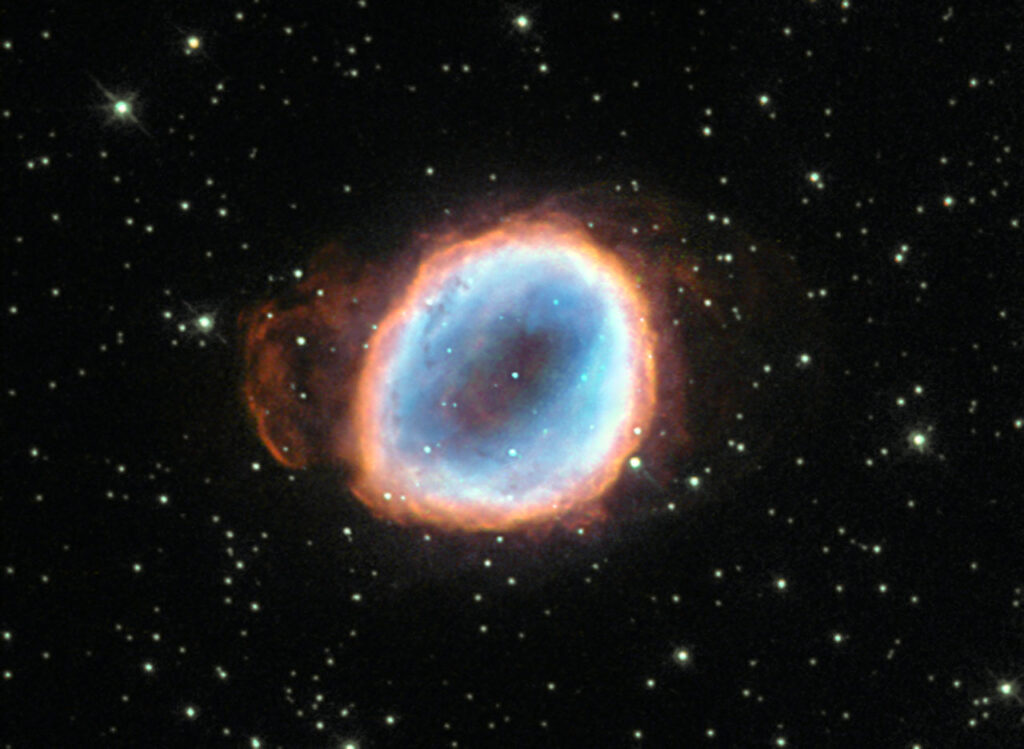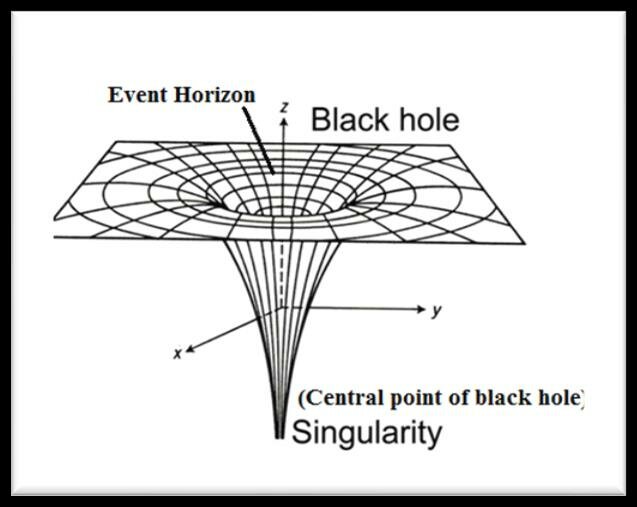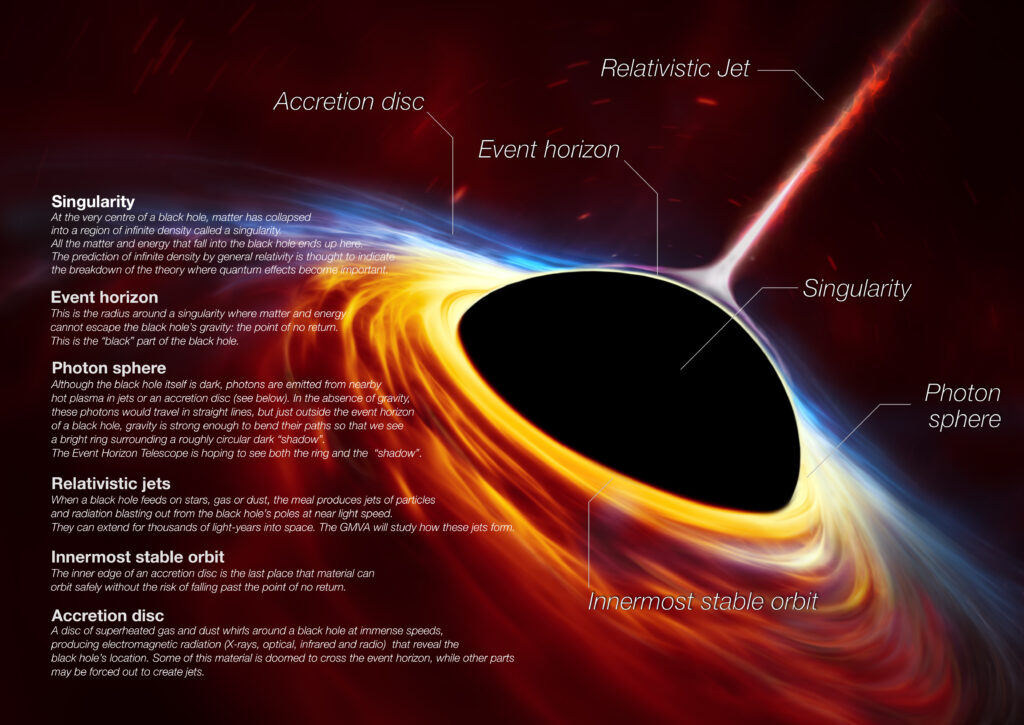Beyond the Horizon
© NASA
Table of Contents
Within the core of a black hole lies a gravitational singularity, a point of infinite density and gravity occupying a one-dimensional space. Here, the laws of physics as we understand them break down, and space-time curves infinitely, creating a region where conventional rules no longer apply. Additionally, the initial state of the universe during the Big Bang is considered a singularity, indicating a point of infinite density.
To fully understand the properties and behaviour of gravitational singularities, we require a comprehensive theory of quantum gravity – a framework that can reconcile the principles of general relativity with the counterintuitive rules of quantum mechanics. Without such a unified theory, the nature of the singularity remains beyond the scope of our current scientific understanding. Physicists continue to search for a theory of quantum gravity, exploring avenues such as string theory, loop quantum gravity, and other innovative approaches. Resolving the mysteries of gravitational singularities is a key driver in this quest, as it could unlock fundamental insights into the most extreme and enigmatic regions of the universe.
FORMATION

Gravitational singularities are a fundamental concept in general relativity, the theory of gravity developed by Albert Einstein. The formation of a gravitational singularity is typically associated with the collapse of massive objects, such as stars, into black holes. When a massive star runs out of fuel, its gravity causes it to collapse inward. If the star is massive enough, this collapse will continue until the matter is compressed into an infinitely small point, known as a singularity.
The Penrose-Hawking singularity theorems, developed by mathematicians Roger Penrose and Stephen Hawking, demonstrate that singularities are a generic feature of general relativity and are inevitable if certain conditions, such as the existence of trapped surfaces, are met.
In summary, gravitational singularities are points in spacetime where the laws of physics break down, and they are typically associated with the collapse of massive objects into black holes or the initial state of the universe in the Big Bang. The formation of these singularities is a robust prediction of general relativity, but their ultimate nature remains an active area of research in theoretical physics.
TYPES OF SINGULARITY

There exists a singular type of singularity, each exhibiting distinct physical attributes that align with the theories from which they originated. These singularities vary in shape, ranging from conical to curved. Some have been theorized to manifest without event horizons, which are structures separating one spacetime region from another, beyond which events cannot influence; these are known as naked singularities.
CONICAL SINGULARITY
A conical singularity is a type of singularity in spacetime that occurs when the limit of a diffeomorphism invariant quantity does not exist or is infinite. This results in spacetime not being smooth at the point of the limit, resembling a cone with the singularity located at the tip. The metric can be finite everywhere in the coordinate system used, but the singularity is characterized by the infinite density and curvature of spacetime at that point. Conical singularities are found in various physical contexts, including cosmic strings and the centers of black holes.
For example, in the Schwarzschild solution, which describes a non-rotating, uncharged black hole, the Kretschmann scalar, a diffeomorphism invariant quantity, is infinite at the center of the black hole, indicating the presence of a singularity. The existence of a singularity can be verified by noting the infinite value of such quantities, which are invariant under different coordinate systems. This type of singularity is distinct from other types, such as curved singularities, which are characterized by different physical features and theoretical origins.
CURVATURE SINGULARITY
A curvature singularity is a fundamental concept that arises in the study of spacetime and gravitational phenomena. Curvature singularities are crucial in understanding extreme gravitational conditions, such as those found in black holes. For instance, a black hole is a classic example of a curvature singularity, where matter collapses to an infinitely dense point, creating a region of infinite gravity. This extreme gravitational pull is so intense that not even light can escape, leading to the formation of an event horizon around the black hole.
One significant characteristic of curvature singularities is their association with event horizons, which delineate regions of spacetime where events cannot influence each other. However, there are also instances of “naked” singularities, which exist without event horizons and pose unique challenges to our understanding of the universe.
In the study of curvature singularities, physicists often encounter points where the metric describing spacetime becomes infinite. While some of these points are regular and merely a result of coordinate system choices, true singularities are identified by the presence of infinite diffeomorphism invariant quantities, which remain infinite regardless of coordinate transformations.
Curvature singularities can manifest in different forms, such as conical singularities and curved singularities. Conical singularities resemble cones in spacetime, while curved singularities, like those found in black holes, exhibit infinite gravity and spacetime curvature. These singularities are geodesically incomplete, meaning that the motion of particles cannot be determined beyond a certain point, signifying the breakdown of predictability in extreme gravitational environments.
NAKED SINGULARITY
A naked singularity is a hypothetical concept in physics that refers to a gravitational singularity without an event horizon. This means that the singularity is directly observable by external observers, unlike black holes where the event horizon encloses the singularity, making it inaccessible to outside observers. In the context of general relativity, a singularity is a point in spacetime where the curvature is infinite, and the laws of physics as we know them break down. Naked singularities are considered a serious challenge to the cosmic censorship hypothesis, which proposes that singularities are always hidden from view by an event horizon.
The existence of naked singularities is theoretically possible, but they have not been observed in nature. The formation of naked singularities is often linked to extreme astrophysical processes such as the collapse of massive stars or the merger of black holes. In these scenarios, the gravitational pull becomes so strong that it can overcome the effects of quantum gravity, potentially leading to the formation of a naked singularity.
Theoretical models and simulations have explored the possibility of naked singularities in various contexts. For instance, the collapse of inhomogeneous stars or nonspherical collapse can lead to the formation of naked singularities. These scenarios are often studied using numerical simulations and analytical solutions to the Einstein field equations. The results suggest that under certain conditions, naked singularities can form and remain stable, defying the predictions of cosmic censorship.
The implications of naked singularities are significant, as they would allow for direct observation of the collapse of matter to infinite density, which is currently inaccessible due to the event horizon of black holes. This could potentially provide new insights into the fundamental laws of physics and challenge our understanding of the behavior of matter at the most extreme conditions.
However, the existence of naked singularities is still a topic of ongoing research and debate in the scientific community. The theoretical frameworks used to study these phenomena are often simplified and do not account for the complexities of real-world astrophysical processes. Therefore, while naked singularities are an intriguing concept, their actual occurrence in nature remains uncertain and requires further investigation to confirm or refute their existence.
IMPLICATIONS

The implications of the Singularity are multifaceted and significant, encompassing various aspects of society and technology. Here is a detailed list of the implications of the Singularity:
- Technological Advancements: Singularity could lead to unprecedented technological growth, surpassing human intelligence and control, potentially resulting in the emergence of superintelligent machines that far exceed human capabilities.
- Labor Market Disruption: Advanced AI entities could displace human workers, particularly those in routine and manual labor while increasing the demand for high-tech skills. This shift could reshape the labor market significantly.
- Cognitive Impact: The development of AI surpassing human intelligence could lead to a new level of cognitive abilities that are unachievable by humans, potentially altering how tasks are performed and decisions are made.
- Economic Transformation: The Singularity could bring about economic changes, impacting industries, businesses, and the workforce. The displacement of human workers by AI could reshape economic structures and employment patterns.
- Social Dynamics: The advent of superintelligent AI could have profound social implications, affecting how societies function, communicate, and interact. It may lead to shifts in social norms, relationships, and structures.
- Ethical Considerations: The Singularity raises ethical dilemmas regarding the control and impact of superintelligent AI. Questions about AI decision-making, accountability, and moral implications become crucial.
- Existential Risks: Concerns have been raised by experts like Stephen Hawking about the potential risks associated with artificial superintelligence, including the possibility of human extinction. Safeguards and ethical frameworks would be essential to mitigate such risks.
- Life Beyond Singularity: Predicting life post-Singularity is challenging, with uncertainties about how AI advancements will shape society, work, and daily life. The benefits and risks of AI singularity remain subjects of speculation and debate.
- Innovation and Progress: Singularity could drive innovation across various sectors, leading to breakthroughs in science, technology, healthcare, and other fields. It may unlock new possibilities and solutions to complex problems.
- Educational Shifts: The rise of superintelligent AI could necessitate changes in education and skill development to prepare individuals for a future where AI plays a central role. New educational paradigms and training programs may be required.
